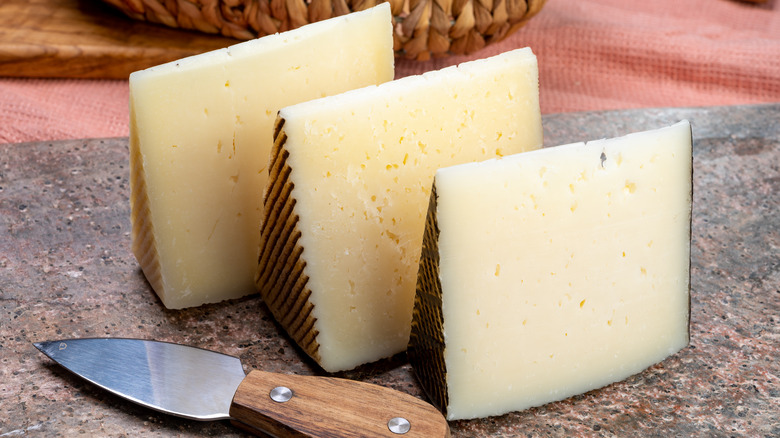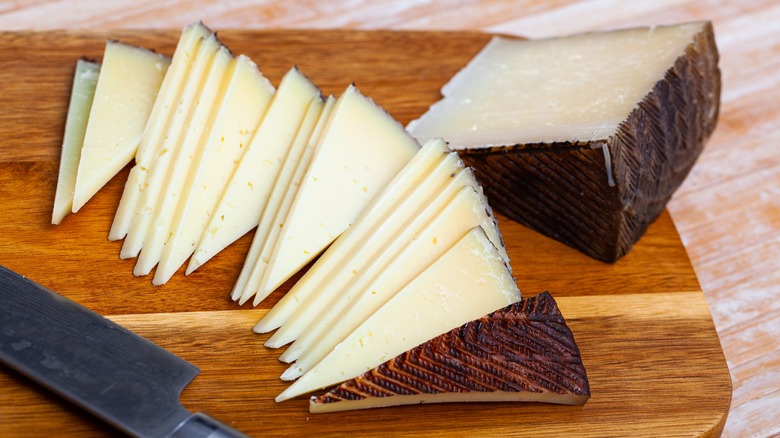How Iberico Cheese Is Different From Manchego
Manchego and Iberico are both well-known Spanish cheeses, but while they may look similar, there's a key difference. What sets them apart is the type of milk they're made with, which gives them each a unique flavor and texture. Manchego is made from sheep milk whereas Iberico uses a mixture of cow, goat, and sheep milk. Both cheeses, although made differently, adhere to strict sets of guidelines in terms of their production.
Manchego cheese has Spanish DOP (Denominación de Origen Protegida) and European PDO (Protected Designation of Origin) status. Just like with Italian Parmigiano-Reggiano (as opposed to parmesan), this means it must meet official criteria to be called Manchego. It can only be made in the La Mancha region of Spain, within the provinces of Albacete, Ciudad Real, Cuenca, and Toledo, using milk from the Manchega breed of sheep. This milk must contain at least six percent fat.
Mixed-milk Iberico cheese, on the other hand, contains specific proportions of each of the three milks. No more than half of it can come from cows, and it has to contain at least 15 percent goat milk as well as a minimum of 15 percent sheep milk to be officially labeled as Iberico. It tends to be a less expensive option to buy than Manchego.
Manchego and Iberico cheese have different tastes and textures
Because it is made solely with sheep milk, Manchego cheese has a semi-hard texture and tastes buttery and slightly nutty with a sweet-sharp balance. The fattiness of the milk gives it extra richness; the finished cheese has a fat content of up to 57 percent.
Manchego must be aged for at least 60 days – though it can be matured for up to two years — and this process also affects its flavor. As it goes from semi curado (aged for around three months) to curado (aged for at least six months), it develops more nuttiness as well as a caramel-like sweetness and more pronounced acidity. It becomes more crumbly and grainy in texture once it's aged for over a year (known as viejo), with a stronger, zestier taste. You can also sometimes find varieties of Manchego or Manchego-style cheeses flavored with other ingredients, such as truffle or rosemary.
Iberico cheese, though it tastes mild, has a complex depth of flavor thanks to its three milks. The cow milk gives it a smooth creaminess, it gets a Manchego-like sweet nuttiness from the sheep milk, and the goat milk adds a bright, acidic tanginess. The hard cheese is aromatic and piquant and sometimes has grassy notes on the palate. It's aged for at least a month but can also be matured for over seven months.
Both cheeses can be used to elevate everyday dishes
If you want to arrange a better cheeseboard or tapas platter, both Manchego and Iberico make a great addition. But they are also versatile enough to be used in lots of different ways when cooking, bringing a Spanish flavor to all sorts of everyday dishes.
Manchego can be grated and substituted for cheddar in many recipes. Try topping homemade chorizo pork burgers with Manchego, or adding it to hot dogs. You could also use it to enrich cheese sauces – it makes an elegant mac and cheese, topped with smoky paprika-spiked breadcrumbs. Stuff it into deep-fried croquetas along with salty Iberico ham, combine it with spicy chorizo as a deliciously melty filling for quesadillas, or spoon spiced ground lamb and nutty Manchego into halved eggplant and bake it for a tasty treat.
As for Iberico cheese, which has a more tangy quality, try drizzling slices with sweet honey for a contrast of flavors. It's delicious when served simply with toasted bread or Spanish torta — just let the cheese come to room temperature for half an hour before you eat it to fully appreciate the flavor. Or, like Manchego, it can also be grated and used to cook with. Use it to top pasta and potato dishes, since it's cheese that melts very well. It also adds a great depth of flavor to rich, savory omelets, or can be sliced and added to salads.



